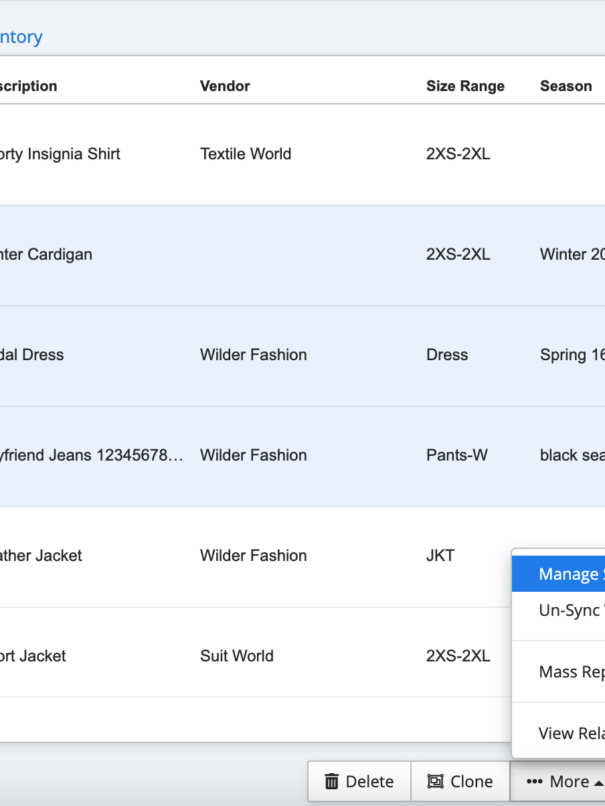Enterprise resource planning (ERP) solutions have emerged as game-changers for apparel companies in today’s fast-paced fashion world. These tools integrate diverse operations such as inventory management, customer relationship management, financial tracking, and forecasting—all under one digital roof.
With an ERP solution like ApparelMagic, businesses can streamline processes, boost efficiency, and make data-driven decisions to stay ahead of the curve. As a result, this invaluable technology has revamped how apparel companies operate, sparking widespread digital transformation in the industry.

But what’s so special about this ERP digital transformation wave, you ask? Well, from real-time insights to improved collaboration, these systems have features in droves to offer for apparel businesses, features that simply cannot be ignored.
Top apparel brands have already experienced the remarkable advantages of implementing ERP systems, successfully propelling their businesses into the digital technology era. So why wait and miss out on opportunities to enhance your operations and boost your bottom line?
Dive in with us as we explore the ins and outs of this remarkable technology, and discover a mind-blowing statistic that might revolutionize how you think about your own business. Trust us—you won’t want to miss this, so join us and embark on a digital transformation journey.
Understanding ERP Solutions
In a nutshell, ERP is a software solution that helps businesses streamline various manual processes, allowing your business to run efficiently. Without a shadow of a doubt, they’ve become essential tools for businesses across various industries.
Now, let’s zoom in on how apparel company ERP systems cater to the needs of creative entrepreneurs that have a penchant for fashion. With countless styles, colors, and sizes to track, managing inventory is no easy task for clothing manufacturers.
Luckily, ERP solutions help consolidate all that data so you can count on your threads without breaking a sweat. And that’s not the end of it. ERP systems also optimize your supply chain management, ensuring that your clothing creations make it to the catwalk and in stores on time and within budget.

Furthermore, by monitoring production workflows, these advanced systems enhance transparency, streamline processes, and ultimately contribute to a more profitable business – an objective every entrepreneur strives for.
Moreover, adopting such solutions allows you to reduce your carbon footprint, ensuring that your products reach customers’ wardrobes in an environmentally responsible manner. So, embrace the power of technology to not only boost your bottom line but also promote sustainability. Plus, it’s a common fact that 47% of apparel businesses fail not long after they launch. Having such a system will help you iron out the details and ensure that everything runs like clockwork.
But it’s not all bells and whistles. Implementing an ERP solution can be challenging for some apparel companies, as it requires integration across all departments and a willingness to embrace change. You can push aside your fears, though! Simply by investing in staff training and taking a phased approach, you can overcome these obstacles and reap the benefits of smoother processes and streamlined operations.
But before we delve into how you can achieve ERP digital transformation, let’s explore the various features ERP software offers.
Key Features of ApparelMagic Software
ApparelMagic boasts many features that stand out among other apparel solutions in the apparel industry. For instance, ApparelMagic can be seamlessly integrated with customer relationship management (CRM) systems, providing an enhanced level of efficiency and organization for your business.
Combining the power of ApparelMagic’s robust features with the comprehensive capabilities of CRM systems will allow you to effectively manage customer data, track sales trends, and so much more.
But that’s not where the future stops. Some of the other vital features of ApparelMagic include:
Inventory Management
ApparelMagic’s robust inventory management system allows businesses to keep track of their products, raw materials, and other assets in real time. This feature enables companies to monitor stock levels, set reorder points, and make smart purchasing decisions. Ultimately, this results in reduced inventory costs and increased sales.
Product Lifecycle Management
AppareMagic is not just an ERP system; it also serves as a product lifecycle management (PLM) solution.
PLM systems help businesses manage every stage of a product’s life, from conception to discontinuation. With ApparelMagic PLM, companies can easily collaborate on designs, monitor the production process, and adapt their strategies to align with ever-changing fashion trends.
Order Management
ApparelMagic’s order management system allows businesses to streamline order processing, invoicing, and shipping. This feature not only ensures efficient handling of sales orders but also reduces the likelihood of errors and improves customer satisfaction.
Business Intelligence Reporting
To make effective business decisions, organizations need access to accurate, up-to-date data. ApparelMagic’s inventory reporting capabilities empower users with real-time analytics, tracking key performance indicators and generating customizable reports. This insight enables apparel companies to make sound decisions and improve the workflow of their entire business.
Embracing the digital transformation of ERP systems offers significant benefits, including a substantial return on investment (ROI) and improved workflow management.
How ApparelMagic Benefits Apparel Businesses
Implementing ApparelMagic as an ERP solution can have numerous benefits for apparel businesses, including:
- Streamlined business processes: By automating tasks and connecting different departments, ApparelMagic reduces delays and redundancies in workflows.
- Reduced operational costs: With better inventory control and order management, businesses can lower their expenses and increase profitability.
- Increased productivity and efficiency: Accurate, real-time data allows businesses to make faster decisions and optimize their operations.
- Improved customer service: By effectively handling orders and providing better visibility into production timelines, businesses can improve the customer experience.
- Streamline your order fulfillment: With a centralized platform, you can efficiently manage orders from numerous sales channels in one place. Such a robust ERP solution helps you streamline your order fulfillment process, enabling you to swiftly and precisely process orders, monitor shipments, and keep your customers well-informed.
Common Pitfalls and Challenges in ERP Implementation
While implementing an ERP system offers many benefits, companies often face various pitfalls and challenges during the implementation phase.
Data Migration
Data migration is one of the most critical aspects of implementing an ERP system, as it lays the foundation for a successful transition. Companies must ensure that data is accurately and securely transferred from their existing system to their chosen ERP platform while also maintaining data integrity and minimizing downtime during the migration process.
To achieve this, organizations should establish a comprehensive data migration plan, which includes thorough data mapping, cleansing, and validation procedures. This will help to reduce the risk of errors and ensure a smooth transition to the new ERP system.
Change Management
Introducing a new ERP system often entails significant changes to business processes and workflows, impacting both employees and the organization as a whole. Effective change management is essential for ensuring that all employees are on board with the new system and have received adequate training to utilize it efficiently.
A strong change management strategy should include clear communication of the reasons behind the ERP implementation, the benefits it will bring to the organization, and the support available to employees during the transition. Involving key stakeholders and end-users in the decision-making process can also help to foster a sense of ownership and increase buy-in from employees.
User Adoption
Ensuring user adoption of the ERP system is another critical challenge companies face. Businesses need to promote the benefits of the new system to their employees and provide ongoing support after implementation to foster a positive user experience. This can be achieved through targeted training programs tailored to different user groups, taking into account their specific needs and skill levels.
Additionally, providing access to user-friendly documentation, online resources, and dedicated helpdesk support can further ease the transition and encourage employees to fully embrace the new company ERP system. By investing in user adoption initiatives, companies can maximize the return on their ERP investment and drive long-term success.
Integrating ERP Solutions Successfully: Best Practices
Integrating ERP with other systems requires a well-thought-out strategy and meticulous planning due to its complexity. Various factors, such as company size, data migration from different systems, and user count, influence the duration and cost of the process. To ensure a successful ERP integration, devising a comprehensive plan is crucial.
The following guide outlines the key steps to consider before embarking on your ERP integration journey.
Determine the Data to Be Integrated
Before merging data into the new system, review and eliminate any redundant information. The effectiveness of enterprise resource planning relies heavily on a well-organized data structure, making thorough data analysis crucial at this stage. Whenever possible, consult source documents to ensure data accuracy and completeness.
Remember that a successful integration depends on error-free and precise data. After verifying the data, develop a plan that consolidates and organizes it into logical segments, accelerating the transition to the new system.
Select the Optimal Integration Techniques
Identify the most suitable integration approaches based on your organization’s needs. At this stage, consider engaging an ERP expert if your budget allows. While your internal team may have extensive knowledge of your business, enlisting the help of ERP specialists can streamline the integration process.
An ERP consultant will ensure that all modifications and implementation steps align with your strategy, objectives, timeline, and budget, resulting in a more efficient integration.
Initiate the Integration Process
Designate a person or group to oversee the integration and keep all employees informed. Incorporate white papers and checklists into your standard operating procedures, making them accessible to the entire organization. After completing the ERP integration, evaluate the results against the goals set by the project team during the planning phase, and ensure all staff members are familiar with using the ERP software post-integration.
Follow these comprehensive steps, and you will be well on your way toward ERP digital transformation.
The Future of Apparel ERP Solutions
The ongoing development of innovative technologies, such as artificial intelligence (AI), machine learning, and the Internet of Things (IoT), is poised to enhance the functionalities of apparel ERP systems. This will enable fashion businesses to automate more processes, gain deeper insights into their operations, and achieve even greater efficiency and growth.
We can expect ERP functions to grow as there will be more software options, more integrations, and more ideas presented by entrepreneurs that will lead the entire industry forward.
But that’s not the only stop. Besides streamlining the back end of apparel business operations, businesses can curate the perfect customer service. With the ability to order custom clothes and add unique features such as emblems and so much more, customers can enjoy a different experience, setting you apart from a slew of apparel businesses that are keen on doing it the old fashion way.
Besides that, you can become a part of the elite group of apparel businesses that focus on delivering beautiful garments in an eco-friendly way by having a completely transparent supply chain.
And all of that is thanks to the cutting-edge technology that is ERP.
Bottom Line
ERP digital transformation helps fashion businesses by streamlining operations, boosting efficiency, and enabling data-driven decisions. This powerful ERP system offers features like inventory management, product lifecycle management, order management, and business intelligence reporting, resulting in reduced operational costs, increased productivity, and improved customer service for apparel businesses.
To successfully implement an ERP system, businesses should follow best practices, including selecting an industry-specific solution, thorough planning, stakeholder involvement, and allocating sufficient time and resources. Overcoming challenges like data migration, change management, and user adoption is crucial for effective implementation.
Take matters into your own hands and start conquering the apparel industry!







